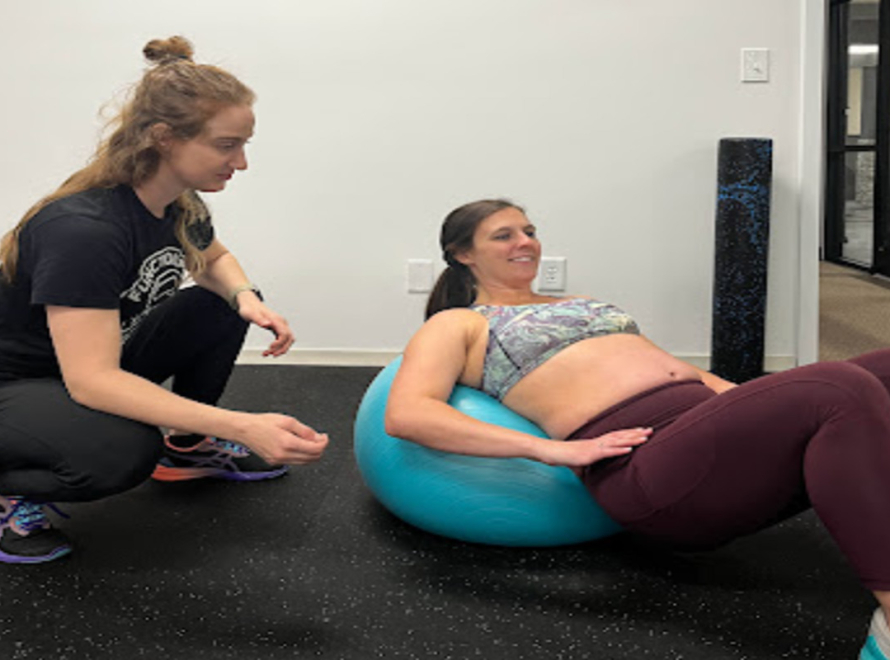Thanks to social media, pelvic floor physical therapy is certainly gaining popularity, but even though you’ve heard the term, do you actually know what it is? You may also be wondering is pelvic floor physical therapy the same as women’s health PT? or Pelvic Health PT? Most of the time these terms are use synonymously. While anybody with a pelvis can have pelvic floor issues, sometimes pelvic floor physical therapists will decide to only treat one gender, such as women, which is why they may refer to themselves as a women’s health physical therapist. At Functional Phyzio however we treat all genders, thus we like to refer to ourselves as pelvic floor (or pelvic health) physical therapists!
What is Pelvic Health Physical Therapy?
Pelvic Floor Physical Therapy in Durham is so much more than just doing Kegels and encompasses addressing & treating not only the pelvic floor but the rest of the body in addition to lifestyle factors. In this blog we’re going to go through all of the ins & outs of pelvic floor physical therapy and help you determine if it’s a service you will benefit from.
How does someone become a pelvic floor physical therapist?
This is such a great question! When someone graduates from PT school they have been exposed to all types of physical therapy from orthopedics, neurological and pediatrics. Some graduates may have taken an elective or had a clinical internship in the area of pelvic floor PT. However most physical therapists who want to specialize in this area must take advanced courses post graduation. Herman & Wallace and the APTA offer weekend intensive courses to learn how to perform internal pelvic floor assessments. While technically anyone could call themselves a pelvic floor physical therapist we think that only therapists who can perform internal assessments and treatment are true pelvic floor physical therapists. Our Pelvic Health PTs have taken multiple courses from Herman & Wallace in addition to specialty courses so you know you are getting treatment from a highly trained clinician.
What kinds of injuries & conditions can be treated in pelvic floor physical therapy?
Pelvic Floor physical therapy encompasses a wide range of issues including:
SI Joint pain & dysfunction
Pain with sex
Recovery from Perineal tears & scars
Round ligament Pain
Do you need a referral to see a pelvic floor physical therapist?
Nope! You can go directly to pelvic floor physical therapy in Durham and don’t need a doctor’s referral. This is awesome because that means going directly to a pelvic floor physical therapist will save you time & money and is a great, non-invasive option. Even if your provider
What do you do at pelvic floor physical therapy?
For starters, we don’t just do kegels! This may be part of your program but the first step is to get a thorough understanding of what is causing your issues.
At your initial appointment, you and your pelvic floor physical therapist in Durham will start by having an in-depth discussion of your issue, medical & birth history if applicable, what makes it better, worse & what you’ve tried so far. We need to know EVERYTHING and nothing is TMI. We also want to know your goals so we can not only help you achieve them but feel better than you ever have!
The next step is to do a full body movement assessment. This is so important because the pelvic floor does not work in isolation from the rest of the body – listen to our podcast “The pelvic Floor as part of a system” to learn more! Do you have limited movement in your hips & spine? That can affect the pelvic floor! Are you unstable when standing & squatting on one leg? That can have a direct impact on the pelvic floor muscles. Not only are we looking at mobility but we will also watch you do the activity you are having issues with such as running, jumping or lifting!
Part of this movement assessment also includes looking at your core function and breathing! The pelvic floor is so intimately connected with our breathing so it’s essential to look at this piece of the puzzle! If you are someone who breaths up into your neck and shoulders instead of letting your belly relax on inhale, you bet we will be working on this!
Internal Pelvic Floor Assessment
Once we have a clear picture of your whole-body movement, we will then look closer at the pelvic floor. With your consent & comfort we will perform an internal pelvic floor muscle assessment. This assessment is done vaginally and / or rectally depending on your needs & prefrences. The internal assessment is where we can see what happens at the pelvic floor when you cough, sneeze, engage your abs and breathe. We do also check the strength of the pelvic floor when performing a contraction or a Kegel, but this alone doesn’t tell the whole story.
Another unique aspect of pelvic floor physical therapy at Functional Phyzio is that we not only check your pelvic floor function lying down but we also do this in standing. By doing an internal assessment in standing we get more useful information on why you may be experiencing your symptoms. Our bodies have to work differently in standing versus lying down so it can absolutely change what is happening at the pelvic floor. Plus, you don’t live your life lying on you back!

Another unique aspect of pelvic floor physical therapy at
Functional Phyzio is that we not only check your
pelvic floor function lying down but we also do this in
standing. By doing an internal assessment in standing we
get more useful information on why you may be experiencing
your symptoms. Our bodies have to work differently in
standing versus lying down so it can absolutely change
what is happening at the pelvic floor. Plus, you don’t
live your life lying on you back!
After all of this we will be able to tell you the root cause of your issue, why this is happening & what we will work on to fix it!
Our 3-step process to recovery:
Reset
Our first step is to reset your movement & mechanics, breathing & address any pain. We utilize a combination of hands-on techniques & basic exercise. During the reset process we also provide a lot of education around lifestyle factors (such as bladder irritants & keeping a bladder diary, stress management and sleep) and activity modification so you can continue to be active without symptoms. The reset phase allows us to build a solid foundation moving forward.
Reload
The reload phase is focused on building up your strength & resilience. During this phase we are able to begin to utilize more weights such as dumbbells, kettlebells, barbells & resistance bands in order to make long term changes in your movement & pelvic floor function.
Perform
Our last phase (and honestly, the most fun phase) is where we continue to build your strength, add in higher level dynamic activities (such as running, jumping & lifting heavy). This phase focuses on getting you stronger than you were before and feeling like yourself again – day in & day out.
What do treatment sessions look like?
While each session is tailored to your specific needs, we will utilize a blend of hands on work such as dry needling – which can be done on the pelvic floor muscles in additions to muscles on other parts of the body, soft tissue work and joint mobilizations.
Exercises may include Kegels, but this doesn’t mean you are going to be lying on your back the whole time doing a “squeeze and lift” with your vagina. We are going to get up, get moving and incorporate the pelvic floor into core & hip strengthening movements.
Another important aspect of pelvic floor physical therapy is ensuring you have good form with running, jumping & lifting. Many times, small tweaks in form can have a huge Impact on the pelvic floor when it comes to reducing symptoms!
Pelvic Floor Physical Therapy is so much more than just looking at the pelvic floor (and doing Kegels). At Functional Phyzio we take a whole body & whole person approach in order to address the root cause & get you back to the workouts and activities you love, symptom free!
Think you may benefit from pelvic floor physical therapy? Contact us today to see if we’ll be a good fit to help you!
Sources: APTA Pelvic Health Section




